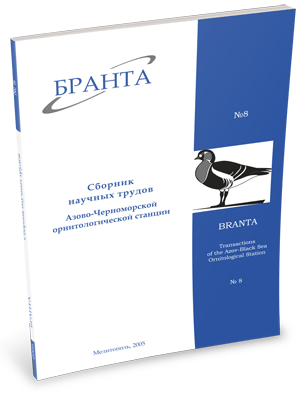
Transactions
of the Azov-Black Sea Ornithological Station



Passerines of Molochnyy Liman in the period of seasonal migrations.
E.A. Diadicheva, V.M. Popenko, A.I. Koshelev
The present paper is a result of long-term observations (in 1975-2004) of the seasonal migrations of Passerines on fixed observation points (OP) or along the census routes. A great deal of data was collected during catching of Passerines in the reedbeds by mist-nets and traps in 1986-1999. Totally more than 9,500 birds were ringed during migration. All materials were collected in the wetlands of Molochnyy Liman and lower reaches of Molochnaya river (at the north-eastern coast of the Sea of Azov) in Zaporizhzhya Region of Ukraine.
At Molochnyy Liman there was recorded a high diversity of Passerines, which in the period of migration were represented by 95 species of 19 families. According to our and literary data throughout the year it was observed 103 species of this order. Such a faunal diversity is determined by habitat characteristics, geographic location and meridional spatial location of the liman. To support this richness of Passerines it is extremely important to preserve both artificial forest plantations and natural reed habitats in plavni*, at the coast and on the spit. In the steppe zone these areas are exploited as stopovers by waterbirds and forest bird species.
The species dominated on spring passage such as Rook (early March), Calandra Lark (mid-March), Starling (late March-early April), Sand Martin and Common Swallow (early May) form main waves of the spring migration. During the autumn passage there dominate Yellow-headed Wagtail (late August), Sand Martin and Common Swallow (early September), White Wagtail (the second half of September), Starling (late September- October), Skylark (mid-October), Chaffinch (mid-October - early November) and Rook (late October - early November). Migration dynamics of scanty species is presented in mean intensity of their control catches. For most of Passerines juveniles dominate in autumn catches, especially in the second half of the migration. Generally for the upper and middle liman the meridional direction of the passage is more expressed, while for the marine spit it is latitudinal, that support an existence both the Azov-Black Sea Migratory Corridor and the meridional one along the river valleys.
Note: plavni –local name of reed areas in the river floodplain
Read the paper in a PDF file